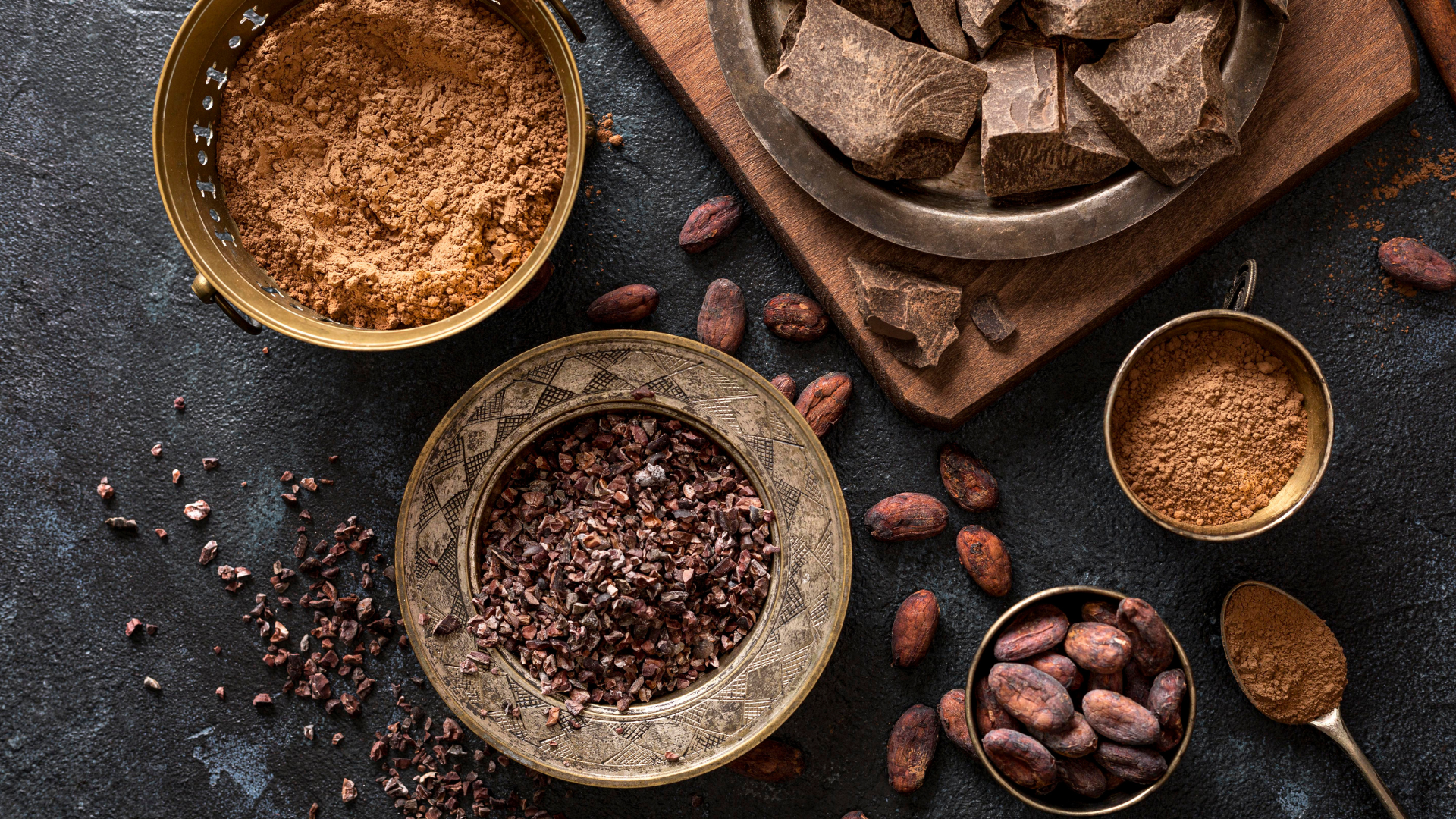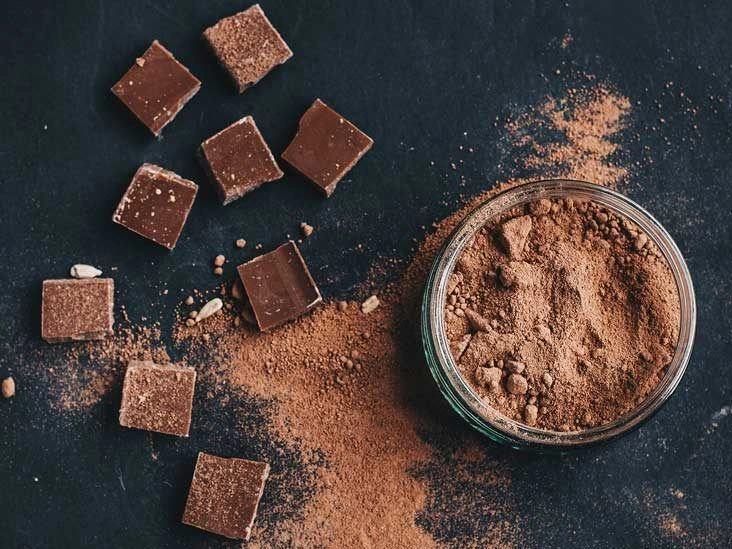Chocolate products often use the labels “cacao” and “cocoa” interchangeably. Both can be healthful in moderation and provide antioxidants, but they may also be calorie-dense.
If you shop for chocolate, you’ve probably noticed some packages advertise cacao while others say cocoa.
You may have spotted raw cacao powder or cacao nibs at health food stores and wondered how they compare with conventional cocoa powder and chocolate chips.
Sometimes there are meaningful differences between these items. Other times, the distinction is mainly marketing language chosen by manufacturers.
This article explains how cacao and cocoa differ and which one is likely the healthier choice.

Terminology
Chocolate originates from cacao seeds — commonly called beans — of the Theobroma cacao tree. This species produces large, pod-like fruits, each containing 20–60 seeds embedded in a sticky, sweet-tart white pulp.
The material inside those beans is the starting point for chocolate products. However, there’s no universal agreement on when to use “cacao” versus “cocoa.”
Some authorities reserve “cacao” for the pods, beans and crushed bean material, and use “cocoa” specifically for the powder remaining after pressing much of the fat from the ground beans.
Producers of raw (unroasted) or minimally processed bean products often opt for “cacao” rather than “cocoa,” which can suggest a more natural product.
Bean-to-bar chocolate makers who craft chocolate from fermented, dried beans commonly call them cacao only before fermentation. After fermentation, they refer to them as cocoa beans.
Because terminology varies, it helps to understand how cacao beans are transformed into chocolate products.
SummaryChocolate comes from seeds (beans) in the pod-like fruit of the Theobroma cacao tree. Labels using “cacao” versus “cocoa” are inconsistent across brands, so don’t assume one is automatically superior or completely different from the other.
How Cacao Beans Are Processed
Raw beans inside the sticky pulp of the cacao pod don’t resemble chocolate in flavor. So even products labeled raw cacao aren’t made from beans taken straight from the pod.
After harvest, cacao beans go through several processing stages. In short, the basic steps are (, 4, ):
- Fermentation: Beans, still with some pulp attached, are placed in containers and covered for a few days so microbes feeding on the pulp can ferment them. This begins to develop the familiar chocolate flavor and aroma.
- Drying: Fermented beans are dried over several days. Once dry, they can be sorted and sold to chocolate manufacturers.
- Roasting: Dried beans are roasted unless a raw product is intended. Roasting deepens the chocolate flavor and adds sweetness.
- Crushing: Beans are cracked and their outer shells removed, yielding broken cacao fragments known as nibs.
- Grinding: Nibs are ground into a paste (often called liquor), which is then ready to be turned into chocolate products.
To produce cocoa powder, the paste — which is about half fat in the form of cocoa butter — is pressed to extract most of the fat.
To make chocolate, the paste is frequently blended with other ingredients such as vanilla, sugar, additional cocoa butter and milk (4).
The percentage of cacao, cocoa or dark chocolate on a bar indicates the combined amount of cocoa powder and cocoa butter. The exact ratio of those components is typically a proprietary detail for each manufacturer.
SummaryAfter harvest, cacao beans undergo processing to build flavor and texture. A bar’s cacao or cocoa percentage generally reflects the total amount of cocoa powder plus cocoa butter present.
Nutritional Comparison of Cacao and Cocoa Products
When you compare nutrition facts for products derived from cacao beans (raw or roasted), the most noticeable differences are calories, fat and sugar content.
Below is a comparison of 1 ounce (28 grams) of several cacao-derived items (6, ):
64160140 1603.5 grams11 grams8 grams13 grams2 grams2.5 grams5 grams8 grams5 grams9 grams1 gram2 grams16 grams6 grams20 grams14 grams0 grams0 grams18 grams9 grams9 grams3 grams1 gram3 grams22% of the RDI4% of the RDI12% of the RDI30% of the RDI
Cacao-based products supply notable amounts of several minerals, including selenium, magnesium, chromium and manganese, though these nutrients often aren’t listed on nutrition panels.
In general, the darker the chocolate — i.e., the greater the cacao proportion — the higher the mineral levels.
Comparing labels won’t reveal differences in antioxidant content, which varies with cacao variety, cultivation conditions and processing techniques.
Typically, less processed cacao subjected to lower heat — like raw cacao — retains more antioxidants.
SummaryCacao items — such as unsweetened cocoa powder, nibs and dark chocolate — are rich in minerals. Minimally processed raw cacao contains little or no added sugar and tends to be higher in antioxidants compared with more processed options.
Health Benefits and Risks of Cacao and Cocoa
Cacao beans and products made from them are abundant in beneficial plant compounds, especially flavanols, which have antioxidant, heart-supportive and potential anti-cancer effects, among other health advantages (, 4).
Cacao also provides iron that is relatively well absorbed by the body compared with some plant-based iron sources. This can be particularly useful for vegetarians and vegans, whose iron sources are more limited.
Cacao products contain tryptophan, an amino acid the body uses to make serotonin, a neurotransmitter that can promote relaxation.
Despite these positives, chocolate can be calorie-heavy. Eating an entire 3-ounce (85-gram) bar of 70% cocoa chocolate would add about 480 calories, 24 grams of saturated fat and 27 grams of added sugars to your intake.
Opting for dark chocolate and unsweetened cacao items like nibs helps reduce the health risks associated with excessive added sugar, including weight gain and tooth decay.
SummaryCacao products are notable for disease-fighting plant compounds, readily absorbed iron and relaxing tryptophan. Still, they can be calorie- and sometimes sugar-rich, so consume them in moderation.
Flavor and Best Uses of Cacao Products
Your selection of cacao products should match your palate and intended use.
For instance, unsweetened cacao nibs are healthier than standard chocolate chips but can taste quite bitter. You might prefer mixing the two as you adjust.

Raw cacao powder may have a superior taste and quality compared with regular unsweetened cocoa powder, though raw versions usually cost more.
If you purchase raw cacao powder, be aware that heating it during baking will destroy some antioxidants. Consider adding raw cacao to smoothies instead.
Try including raw cacao nibs in trail mix or other no-heat recipes to preserve their antioxidant content.
SummaryLess processed, unsweetened and raw cacao items can be bitter, but you may become used to the flavor. Baking with raw cacao will reduce some of its antioxidants, so use uncooked preparations when possible.
The Bottom Line
Labels using “cacao” versus “cocoa” are inconsistent across products.
Generally, raw cacao products — derived from fermented, dried, unroasted beans — are less processed and often healthier.
Still, conventional dark chocolate with at least 70% cocoa remains a solid source of antioxidants and minerals.
Choose the cacao-rich options that suit your taste and budget, and enjoy them in moderation since all are calorie-dense.


















Leave a Reply
You must be logged in to post a comment.